Durgä - the wife of Lord Çiva, also known as Çakti, Mahävidyä, Kälé, Çyämä, and Nistäriëé. She presides over the material energy and is one of the five deities worshiped by the païcopäsakas.

Jai Mata Di Shakti de maa!.mp3
Durga Saptasati Durga Puja Mantra.mp3
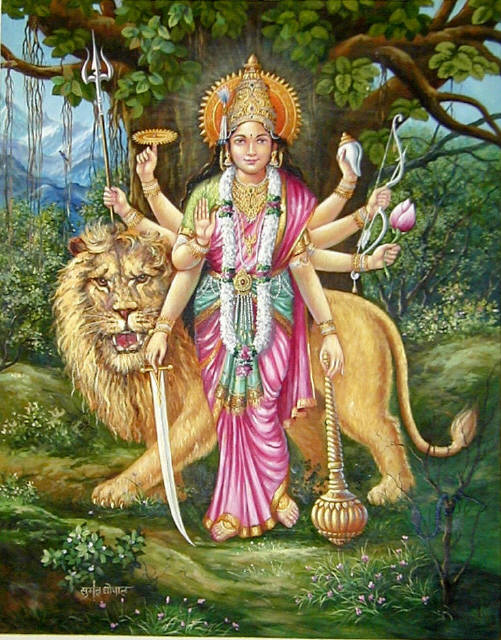
Resultados de la búsqueda
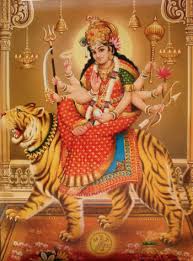 |  | 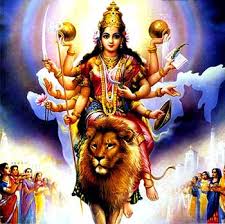 | 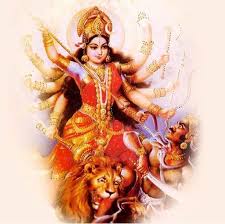 |
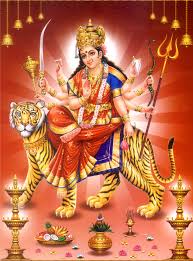 | 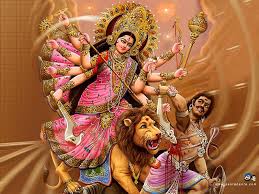 | 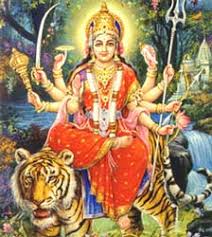 | 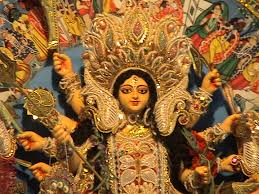 |
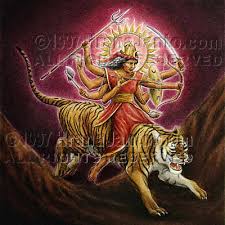 | 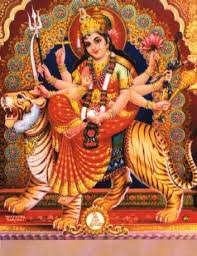 | 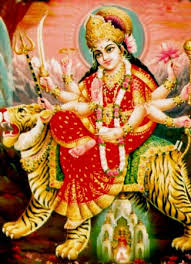 | 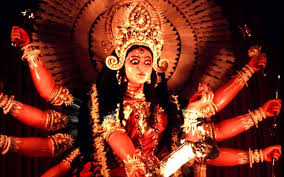 |
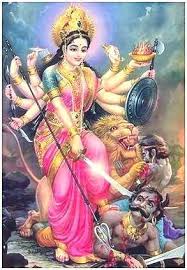 | 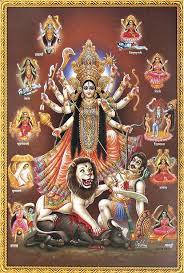 | 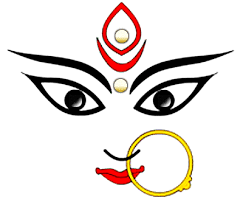 | 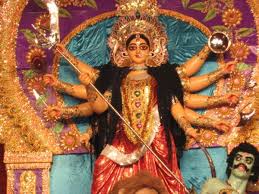 |
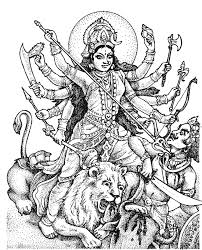 | 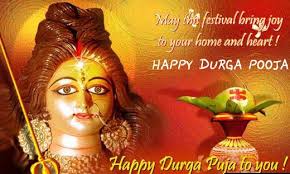 | 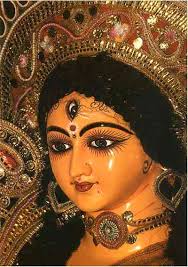 |  |
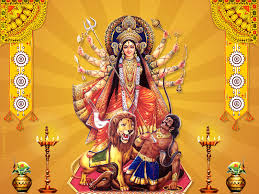 | 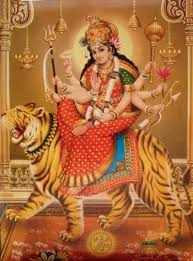 | 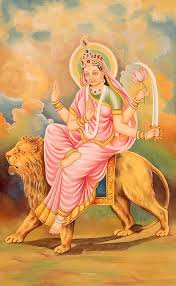 | 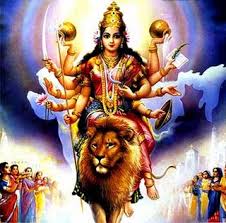 |
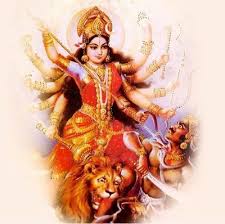 | 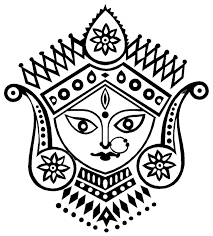 | 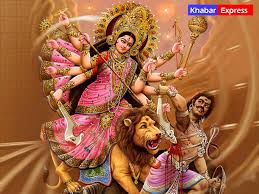 | 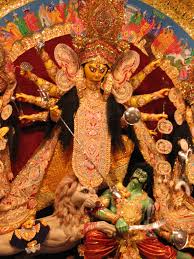 |
 |  |  | 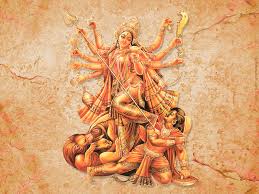 |
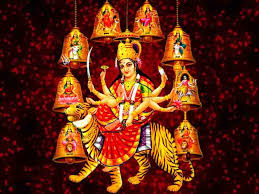 | 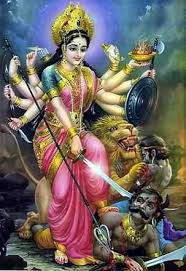 |  |  |
 | 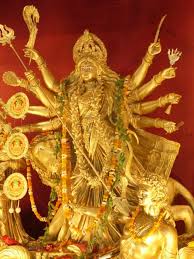 | 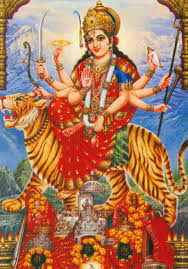 | 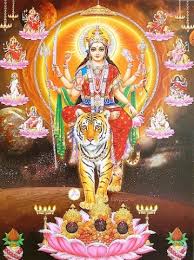 |
Durga
From Wikipedia, the free encyclopedia
| Durga | |
|---|---|
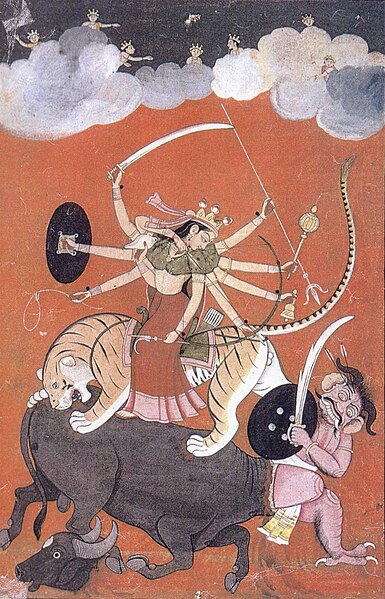 | |
| Vengeance / Victory | |
| Devanagari | दुर्गा |
| Bengali | দুর্গা |
| Affiliation | Avatar of Devi |
| Abode | Kailash |
| Mantra | Om Dum Durgayei Namaha Om Aing Hring Kling Chamundayei Vichche |
| Weapon | Trishula (trident), Chakram, Scimitar, Snake, Conch shell, Mace, Bow, Talwar (longsword), lotus, Thunderbolt |
| Consort | Shiva |
| Mount | Dawon (tiger or lion) |
| This article needs additional citations for verification. Please help improve this article by adding reliable references. Unsourced material may be challenged and removed. (October 2009) |
In Hinduism, Durga (दुर्गा, "the inaccessible"[1] or "the invincible") or Maa Durga (Mother Durga) "one who can redeem in situations of utmost distress".[citation needed] Durga is a form of Devi, the supremely radiant goddess, depicted as having ten arms, riding a lion or a tiger, carrying weapons and a lotus flower, maintaining a meditative smile, and practicing mudras, or symbolic hand gestures.
An embodiment of creative feminine force (
Contents |
[edit] Legend
The word Shakti means divine feminine force, and Durga is the warrior aspect of the Divine Mother. Other incarnations include Annapurna and Karunamayi (karuna = kindness). Durga's darker aspect Kali is represented as the consort of the god Shiva, on whose body she is often seen standing.
Durga's form is blindingly bright, as a radiant goddess (devi), with three lotus-like eyes, ten powerful hands, lush hair with beautiful curls, a red-golden glow from her skin and a quarter moon on her forehead. She wears a shiny attire emitting fierce rays. Her jewellery is beautifully made of gold with ocean pearls and precious stones embedded in it.
As a goddess, Durga's feminine power contains the energies of the gods. Each of her weapons was gifted to her by various gods: Rudra's trident,
According to a narrative in the Devi Mahatmya
It is said that upon initially encountering Durga, Mahishasura underestimated her, thinking: "How can a woman kill me, Mahishasur — the one who has defeated the trinity of gods?"[citation needed] However, Durga roared with laughter, which caused an earthquake which made Mahishasur aware of her powers.
And the terrible Mahishasur rampaged against her, changing forms many times. First he was a buffalo demon, and she defeated him with her sword. The he changed forms and became an elephant that tied up the goddess's tiger and began to pull it towards him. The goddess cut off his trunk with her sword. The demon Mahishasur continued his terrorizing, taking the form of a lion, and then the form of a man, but both of them were gracefully slain by Durga.
Then Mahishasur began attacking once more, starting to take the form of a buffalo again. The patient goddess became very angry, and as she sipped divine wine from a cup she smiled and proclaimed to Mahishasur in a colorful tone — "Roar with delight while you still can, O illiterate demon, because when I will kill you after drinking this, the gods themselves will roar with delight".[cite this quote] When Mahashaur had half emerged into his buffalo form, he was paralyzed by the extreme light emitting from the goddess's body. The goddess then resounded with laughter before cutting Mahishasur's head down with her sword.
Thus Durga slew Mahishasur, thus is the power of the fierce compassion of Durga. Hence, Mata Durga is also known as Mahishasurmardhini — the slayer of Mahishasur. According to one legend, the goddess Durga created an army to fight against the forces of the demon-king Mahishasur, who was terrorizing Heaven and Earth. After ten days of fighting, Durga and her army defeated Mahishasur and killed him. As a reward for their service, Durga bestowed upon her army the knowledge of jewelry-making. Ever since, the Sonara community has been involved in the jewelry profession [3].
The goddess as Mahisasuramardhini appears quite early in Indian art. The Archaeological Museum in Matura has several statues on display including a 6-armed Kushana period Mahisasuramardhini that depicts her pressing down the buffalo with her lower hands [4]. A Nagar plaque from the first century BC - first century AD depicts a 4-armed Mahisamardhini accompanied by a lion. But it is in the Gupta period that we see the finest representations of Mahisasuramardhini (2-, 4-, 6-, and at Udayagiri, 12-armed). The spear and trident are her most common weapons. a Mamallapuram relief shows the goddess with 8 arms riding her lion subduing a bufalo-faced demon (as contrasted with a buffalo demon); a variation also seen at Ellora. In later sculptures (post-seventh Century), sculptures show the goddess having decapitated the buffalo demon.
[edit] Worship
The four day long Durga Puja is the biggest annual festival in
The day of Durga's victory is celebrated as Vijayadashami (Bengali), Dashain (Nepali) or Dussehra (Hindi) - these words literally mean "the Victory Tenth" (day).[5]
In
The actual period of the worship however may be on the preceding nine days (Navaratri) followed by the last day called Vijayadashami in North India or five days in Bengal (from the sixth to tenth day of the waxing-moon fortnight). Nine aspects of Durga known as Navadurga are meditated upon, one by one during the nine-day festival by devout
In North India, the tenth day, signifying Rama's victory in his battle against the demon
In Mysore
In
The Goddess Durga is worshiped in her peaceful form as Maha Gauri, The Fair Lady, Shree Shantadurga also known as santeri, is the patron Goddess of Goa. She is worshiped by all Goan Hindus.
In Maharashtra, Tulja Bhavani is worshiped as Mahishasur Mardini and is patron goddess of land. Bhavani is known as Tulaja,Amba, Renuka, Yamai, Saptshrungi, Jogai in different places of Maharashtra. She is inspirational goddess of Raja shivaji. As per legends, Bhavani revealed to Shivaji and blessed him to form a kingdom.
.
[edit] Notable temples in India and Indonesia
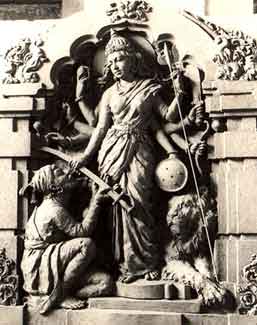
- Ammathiruvadi Temple, Thrissur,
Kerala , India - Matrimandir in the city of Auroville near
Pondicherry inTamil Nadu . - Tulaja Bhavani Mandir, Tualajapur in Maharashtra, India
- Ambika Mata Temple in the village of Jagat near Mount Abu in
Rajasthan , India. - Kulanjari Mata Temple in the village of Mau Chirayal, village of Pundhir near Aligarh in
Uttar Pradesh , India. - Bhairabi Devalaya, in Tezpur, Assam
- Kalighat Temple, Kolkata.
- Kamakhya Temple, Guwahati, Assam
- Tara Tarini Temple, Berhampur, Orissa
- Kanaka Durga Temple, Vijayawada,
Andhra Pradesh - Shanta Durga temple in Goa
- Shila Devi temple at Amber
Jaipur Rajasthan - Shitla Mata temple at
Patna Bihar - Vindhyachal temple near Kashi
- Amaramkavu temple at Kolani Thodupuzha Kerala
- Chintpurni Temple at una
Himachal Pradesh - Jwalamukhi Temple - Kangra, Himachal Pradesh
- Chamunda Devi - Kangra, Himachal Pradesh
- Chamundeshwari Temple, Mysore Karnataka
- Mookambika Temple - Kollur, Karnataka
- Kateel Temple - Kateel, Karnataka
- Jhakhu Temple -
Shimla , Himachal Pradesh - Naina Devi Temple - Bilaspur Himachal Pradesh
- Bhimakali Temple - Sarhan Himachal Pradesh
- Hadimba Devi Temple - Manali Himachal Pradesh
- Balasundari Temple - Nahan Himachal Pradesh
- Prambanan Temple - Indonesia
- Tulja Bhavani Temple - in Tuljapur,Maharashtra, India
[edit] See also
- Kali
- Durga Puja
- Shantadurga
Hindu Goddess - Kala, husband of Durga in Javanese mythology.
- List of women warriors in folklore, literature, and popular culture
[edit] References
- ^ "Durga".
Encyclopædia Britannica Online. http://www.britannica.com/EBchecked/topic/174252/Durga. Retrieved October 7, 2009. - ^ McDaniel, June. Offering Flowers, Feeding Skulls: Popular Goddess Worship in
West Bengal . p. 225. - ^ G. S. Purswani "Incredible Origin and History of Khudabadi Sindhi Swarankar"-2005 Jaipur
- ^
R. C. Agrawala, "The Goddess Mahisasuramardini in Early Indian Art", Artibus Asiae, Vol. 21, No. 2 (1958), pp. 123-130 - ^ Esposito, John L.; Darrell J. Fasching, Todd Vernon Lewis (2007). Religion & globalization: world religions in historical perspective.
Oxford University Press. p. 341. ISBN 0195176952.
[edit] Further reading
- Durga Puja: Yesterday, Today and Tomorrow, Sudeshna Banerjee, Rupa and Co,
Calcutta , 2004. (ISBN 81-291-0547-0) - Hindu Goddesses: Vision of the Divine Feminine in the Hindu Religious Traditions, David Kinsley. (ISBN 81-208-0379-5)
- Grace and Mercy in Her Wild Hair : Selected Poems to the Mother Goddess,
Ramprasad Sen (1720–1781). (ISBN 0-934252-94-7) - Durga Puja Beginner, Swami Satyananda
Saraswati , Devi Mandir, 2001. (ISBN 1-887472-89-4) - "Chandi Path", Swami Satyananda Saraswati, Devi Mandir (ISBN 1-877795-52-6)
- "Chandi Path: Study of Chapter One", Swami Satyananda Saraswati, Devi Mandir (ISBN 1-877795-58-5)
- "Chandi Path: Study of Chapter Two", Swami Satyananda Saraswati, Devi Mandir (ISBN 1-877795-60-7)
- Offering Flowers, Feeding Skulls: Popular Goddess Worship in West Bengal, June McDaniel,
Oxford University Press , 2004. (ISBN 0195167910) - "Pronunciation and the Chandi Samputs", Swami Satyananda Saraswati, Devi Mandir (ISBN 1-877795-61-5)
- "Devi Gita", Swami Satyananda Saraswati, Devi Mandir (ISBN 1-877795-56-9)
- The Bond Between Women: A Journey to Fierce Compassion, China Galland, Riverhead Trade Publishing, U.S., 1999.
- Mahishasura Mardini Stotram (Prayer to the Goddess who killed Mahishasura), Sri Sri Sri Shankara Bhagavatpadacharya
[edit] External links
| Wikimedia Commons has media related to: Durga |
Durga Puja at NetGlimse.com- Durga Puja (calcuttaweb.com)
- Durga at the Open Directory Project
- 108 names of Durga from the Durgāsaptaśatī
| |||||||||||||||||
Diosa madre - Wikipedia, la enciclopedia libre
Durga
durga
Resultados de vídeo de Durga

"Jai Ambe Gauri" - Aarti of Goddess Durga
8 min - 7 May 2008
www.youtube.com
Durga Chalisa
9 min - 31 May 2008
www.youtube.comMantras del mundo: Kali - Durga
Energía Creativa:
Parvati , kali y Durga.Durga - Wikipedia, the free encyclopedia
- [ Traducir esta página ]Goddess Durga: The Mother Goddess & Her Symbolism
- [ Traducir esta página ]Hindu Goddesses : Durga -
- [ Traducir esta página ]Hindu goddess that kills your demonsDurga Temple
- [ Traducir esta página ]Durga
Página PRINCIPAL
OBRAS y AUTORES CLÁSICOS
Agradecimientos
Cuadro General
Disculpen las Molestias
| Conceptos Hinduistas (1428)SC |
|---|
Category:Hindu (mythology) (3256)SC | Category:Hindu mythology (3270)SC | Categoría:Mitología hindú (3288)SC (indice) | Categoría:Mitología hindú (videos) (3289)SC | Conceptos Hinduista (A - G) SK y SC (videos) (3294)SC Aa-Anc · Aga - Ahy · Ai - Akshay · Akshe - Amshum · Ana - Ancie · Ang - Asvayu · Ata - Az · Baa-Baz · Be-Bhak · Bhal-Bu · C · Daa-Daz · De · Dha-Dry · Du-Dy · E · F · Gaa-Gayu · Ge-Gy · Ha-He · Hi-Hy · I · J · K · Ka - Kam · Kan - Khatu · Ki - Ko · Kr - Ku · L · M · N · O · P · R · S · Saa-San · Sap-Shy · Si-Sy · Ta - Te · U · V · Ve-Vy · Y · Z |
| Conceptos Hinduistas (2919)SK | (2592)SK |
|---|
Aa-Ag · Ah-Am · Ana-Anc · And-Anu · Ap-Ar · As-Ax · Ay-Az · Baa-Baq · Bar-Baz · Be-Bhak · Bhal-Bhy · Bo-Bu · Bra · Brh-Bry · Bu-Bz · Caa-Caq · Car-Cay · Ce-Cha · Che-Chi · Cho-Chu · Ci-Cn · Co-Cy · Daa-Dan · Dar-Day · De · Dha-Dny · Do-Dy · Ea-Eo · Ep-Ez · Faa-Fy · Gaa-Gaq · Gar-Gaz · Ge-Gn · Go · Gra-Gy · Haa-Haq · Har-Haz · He-Hindk · Hindu-Histo · Ho-Hy · Ia-Iq · Ir-Is · It-Iy · Jaa-Jaq · Jar-Jay · Je-Jn · Jo-Jy · Kaa-Kaq · Kar-Kaz · Ke-Kh · Ko · Kr · Ku - Kz · Laa-Laq · Lar-Lay · Le-Ln · Lo-Ly · Maa-Mag · Mah · Mai-Maj · Mak-Maq · Mar-Maz · Mb-Mn · Mo-Mz · Naa-Naq · Nar-Naz · Nb-Nn · No-Nz · Oa-Oz · Paa-Paq · Par-Paz · Pe-Ph · Po-Py · Raa-Raq · Rar-Raz · Re-Rn · Ro-Ry · Saa-Sam · San-Sar · Sas-Sg · Sha-Shy · Sia-Sil · Sim-Sn · So - Sq · Sr - St · Su-Sz · Taa-Taq · Tar-Tay · Te-Tn · To-Ty · Ua-Uq · Ur-Us · Vaa-Vaq · Var-Vaz · Ve · Vi-Vn · Vo-Vy · Waa-Wi · Wo-Wy · Yaa-Yav · Ye-Yiy · Yo-Yu · Zaa-Zy |










No hay comentarios:
Publicar un comentario